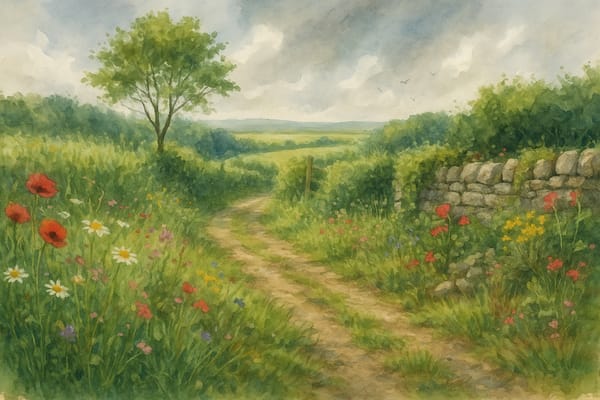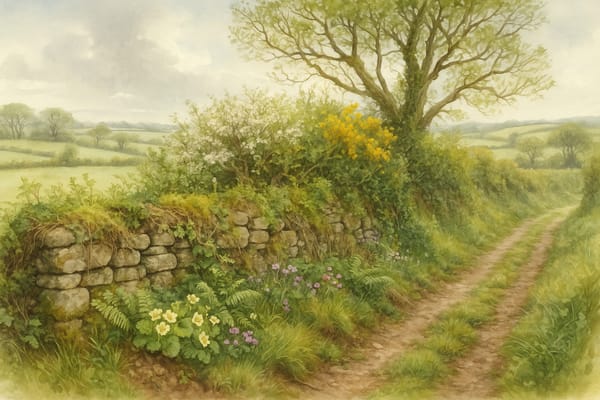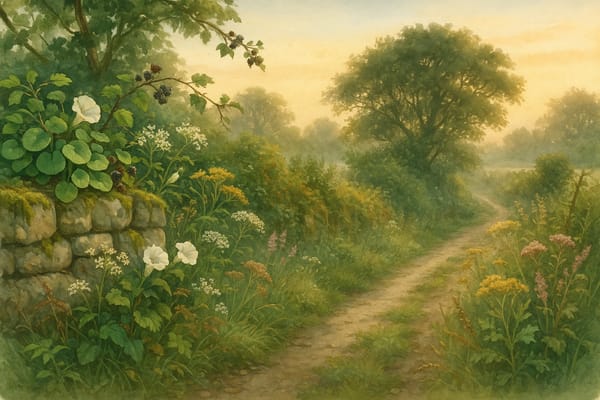There’s something quietly powerful about standing in a Cornish lane in late summer, when the verges spill over with wildflowers, bees hum between clover heads, and the soft hum of life vibrates in the air. In moments like this, nature feels less like a background and more like a living, breathing neighbour.
It’s no wonder, then, that the idea of rewilding has captured imaginations across Cornwall—and beyond. But while the word conjures visions of wild woods, free-roaming animals, or vast untamed landscapes, the heart of rewilding is much simpler.
At its best, rewilding isn’t about going back in time or giving up on the garden altogether. It’s about stepping back, even just a little, and letting nature reclaim her place—whether in a quiet corner of a farm field, the edge of a churchyard, or the smallest patch of your own back garden.
What Rewilding Really Means
Rewilding is an invitation—to nature, and to ourselves.
It’s about letting natural processes unfold, about allowing wild plants, insects, birds, and animals to weave back into the spaces we share. And often, it starts with the simplest act of all: doing a little less.
In Cornwall, with its ancient field patterns, centuries-old hedgerows, and gentle climate, rewilding isn’t a radical act. It’s a natural next step. Here, letting the land soften and self-heal taps into deep, living traditions of working with—not against—the natural world.
What Rewilding Isn’t
There are plenty of myths around rewilding. That it means letting your garden turn into an impenetrable thicket. That it’s messy. That it’s only for sprawling estates or rugged moorland. None of these hold true.
Real rewilding—especially in gardens—is a balance between letting go and gently guiding. It’s about observing, intervening less, and creating spaces where both wildlife and people feel at home. A patch of longer grass, a self-seeded foxglove by the gate, a hedgerow allowed to bloom—these small acts hold surprising power.
Rewilding Success Stories in Cornwall
Across the Duchy, small steps are adding up:
- Roadside verges managed for wildflowers now brim with pollinators and lock away carbon in their roots and soil.
- Churchyards and community spaces are thriving wildlife havens, thanks to ‘cut less, bloom more’ strategies.
- Cornish hedges — already miniature ecosystems — are being planted and restored with wild species, strengthening ancient habitat corridors.
- Farm meadows and garden edges are being allowed to flower and seed, providing food and shelter for hedgehogs, butterflies, and bats even in urban areas.
Cornwall’s mild weather and landscape diversity make it uniquely suited to this kind of small-scale, people-led rewilding—where even a single pot of native wildflowers can connect into a wider web of life.
Busting Common Rewilding Myths
| Myth | Truth |
|---|
| “Rewilding means doing nothing” | It’s about thoughtful less doing—like mowing less often, letting wildflowers bloom, and creating gentle interventions. |
| “It’ll make my garden look a mess” | Informal planting can be stunning — think vibrant meadows, soft borders, and the wild beauty of native blooms. |
| “It’s only for big landowners” | Even a balcony, a verge, or a window box can be part of a living wildlife corridor. |
| “It just means weeds take over” | So-called “weeds” like dandelion, clover, and herb robert are vital nectar sources and soil supporters. |
Simple First Steps to Rewild Your Space
You don’t need a grand plan. You just need a beginning.
- Let the Lawn Grow — Try mowing every three to four weeks or leave a patch unmown altogether. Watch wildflowers return.
- Rethink “Weeds” — Get to know your native wild plants. Nettles, dandelions, and herb robert are crucial for pollinators and other wildlife.
- Ditch Garden Chemicals — Healthy soil and natural diversity are better at pest control than any spray.
- Plant Native Species — Favour foxglove, red campion, thrift, honeysuckle, rowan, and hawthorn—plants that thrive in Cornwall and support its native species.
- Add Simple Wildlife Features — A small pond, a log pile, or a nest box are all invitations to wildlife.
Embrace the Seasons
Letting go doesn’t mean giving up—it means leaning in to nature’s rhythms. Leave seed heads standing in winter, let fallen leaves shelter the soil, and marvel at the quiet industry of fungi, birds, and insects making use of what’s left behind.
Why Rewild Now?
Across Cornwall, as across the UK, native wildlife is in quiet crisis. Hedgehogs, pollinators, birds—all facing sharp declines. But rewilding offers hope. It’s a grassroots, practical response that any gardener can take part in.
By embracing rewilding—one patch, one pot, one corner at a time—you help reverse biodiversity loss, restore soil health, and reconnect with nature in the most personal, joyful way.
Start Small, Think Big
You don’t have to rewild the whole garden. Start with a corner of lawn. Let a few wildflowers seed themselves. Watch who comes to visit.
In Cornwall, where nature already runs close to the surface, rewilding doesn’t just protect the landscape—it deepens our connection to it. And when we open our gardens to the wild, the wild finds its way back to us.











